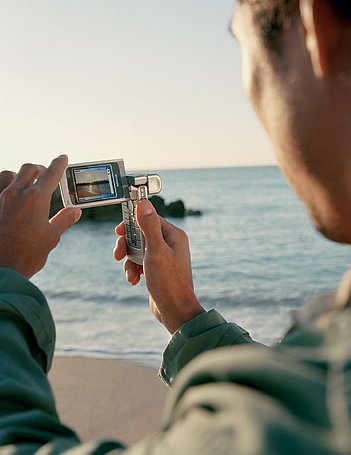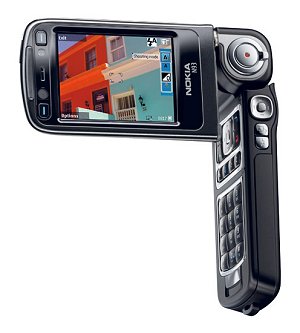Living with the transformer
So the Nokia N90 is (roughly) six months old and has hit that sweet spot of being both available widely and also pretty mature in terms of its firmware, with the latest v5.0607 firmware having seen off any teething bugs and issues. You'll have read Ewan's in-depth review just before Christmas, but how does the N90 fare day to day now that it's mature? I've been living with one and using it to document a trip away, in order to find out....
 As reported in the original review, the N90 is big, but in a surprising way. Its plan dimensions aren't that much bigger than the N70, its closest relative, but it's thick. It's very thick, almost as thick as the recently-derided N80, at not far off an inch. But, as Ewan said, once you start opening and flipping the N90 into its various modes, the size is forgotten and the N90's certainly smaller than a portable digicam, which is what most onlookers will take it for. Having said that, the N90's videos are of lower resolution than all but the cheapest camcorders, so the size/quality thing remains something of a compromise. The biggest benefit of having the N90's camera available is that it's just that - available, and always with you, unlike a camcorder which will always get left behind just when you need it most....
As reported in the original review, the N90 is big, but in a surprising way. Its plan dimensions aren't that much bigger than the N70, its closest relative, but it's thick. It's very thick, almost as thick as the recently-derided N80, at not far off an inch. But, as Ewan said, once you start opening and flipping the N90 into its various modes, the size is forgotten and the N90's certainly smaller than a portable digicam, which is what most onlookers will take it for. Having said that, the N90's videos are of lower resolution than all but the cheapest camcorders, so the size/quality thing remains something of a compromise. The biggest benefit of having the N90's camera available is that it's just that - available, and always with you, unlike a camcorder which will always get left behind just when you need it most....
As I showed a few days ago, the N90's still images are very impressive in terms of focus and detail, although lacking a little in terms of 'feel' compared to the theoretically inferior N70. Somehow the colours produced by the N90's Carl Zeiss camera module seemed not quite as spectacular as those from its cheaper brother. There's no doubting the detail though, with the 'press gently to focus, then press harder to take the shot' system working very well and with crystal clear still images even when snapped only a foot away.
As many readers will know, I've been experimenting with capturing video on the N70 (and now N90). Although the auto-focus system is only for still images, there's extra clarity that comes from the better, more professional optics, and I found MP4 videos recorded on the N90 to have slightly more detail. Here's a (4MB) clip of a steam train, shot last weekend on the N90, so you can see the quality of the video capture and judge for yourself.
The swivelling camera module has other benefits than simply looking cool and doubling up object and self-photography. Being able to set it at any angle makes it far more convenient to shoot stills or video without having to wave the device around in people's faces. The screen can be positioned at a range of angles, too, giving a lot of flexibility. For anyone photographing children (your own, obviously!), the candid nature of being able to set up the camera in non-obvious ways means that you can often get natural shots with the N90 where the subject would be otherwise put off by having a traditional camera system at eye level pointing at them.


Example still images taken with the auto-focussing N90 last weekend, click each thumbnail to see it in original resolution (roughly 500K each)
The N90 marked the point at which Series 60 (S60) finally broke free of the 176 by 208 pixel screen, as it has a 352 by 416 pixel screen instead. As you'll have spotted from the doubled numbers, this makes for easy rescaling of applications to fill the larger screen. The built-ins (e.g. Calendar, Messaging, Clock, Web) all work in the native higher resolution, but most third party applications work in a pixel-doubled mode that's functional, if slightly jarring after the smooth graphics on the screen the rest of the time. I haven't yet seen a third party program that takes advantage of the extra pixels. Where the high resolution screen really shines, of course, and the reason it was specified for the N90, is when displaying photos and videos, all of which appear pin-sharp and impressive. The N90 is the only way to get a high-res screen without making the jump to S60 3rd Edition, another reason why this device is somewhat unique.
The battery issue
Away from the camera, the N90 is more standard, of course. I found it slightly slower than the N70 in terms of screen response, but then there are four times as many pixels to throw around, which presumably has some effect. Speed isn't a real issue though - most people who complain about the N70's speed aren't using it properly.
More worryingly, the camera module literally eats up battery life and with significant camera use (an hour or so) you'll be lucky to get a full day's use from a single charge. Part of the blame must lie with the smaller battery used in the N90 - the BL-5B is a full 12% lower in capacity than the BL-5C used in most other S60 smartphones, which is a shame given the camera's ravenous appetite for power. Away from the camera, power consumption is average for a S60 smartphone, i.e. pretty good.
Having just seen the Wi-Fi-enabled N80 with the same small battery, maybe it's a new Nokia rule, that the more power-hungry the device, the smaller and less capable the battery should be. The N80's form factor may have dictated its battery choice, but there's plenty of room in the relatively bulky N90.
Those hinges
One concern I had when I saw the number of hinges and swivels in the N90 was its robustness. Would it stand up to the rough and tumble of daily life? The review unit I've been trialling had previously been through a number of journalists and was looking rather bashed about, with missing camera lens cover, scratched chrome side panels and the tell tale chip signs of a drop or two on the device's bottom. Despite all this, the N90's hinges and screen/camera swivels were each still rock solid and there were no signs of any cable malfunctions. My first reaction to all this was surprise - as a natural pessimist, I'd expected that it would be falling apart by now - so kudos to Nokia's design and production teams for a top quality product in this department.
As a result of everything mentioned above, and despite the relative bulk and poor battery life, I'm going to extend my use of the N90 as primary smartphone, at least until the next generation (see below) comes along. Is the N90 a better all-round smartphone than the N70? No. But it's really not that far behind in most areas and suprasses it in the area of multimedia capture and playback, which is one of my priorities as a journalist and family man(!)
The future
Transformer phones have popped up every now and then in Nokia's smartphone game plan. First we had the 6260, the first instance of the swivelling clamshell design, though it was let down by an over-fragile hinge and low-spec camera. The idea was good though, which is why the N90 appeared, building in the pinnacle of S60 2nd Edition software, a professional-grade camera and a far sturdier hinge mechanism.
 Next to come are a pair of top-spec S60 3rd Edition devices, the N92 (with focus on built-in DVB-H digital TV receiver) and the N93 (with focus - no pun intended - on N90-like professional optics and DVD-quality video recording). Both devices are very similar in terms of form factor and feature a slightly simpler swivel mechanism and hinge than the N90.
Next to come are a pair of top-spec S60 3rd Edition devices, the N92 (with focus on built-in DVB-H digital TV receiver) and the N93 (with focus - no pun intended - on N90-like professional optics and DVD-quality video recording). Both devices are very similar in terms of form factor and feature a slightly simpler swivel mechanism and hinge than the N90.
Interestingly, Nokia have learned the battery lesson from the N90, with the N92 having a 1500mAh BP-5L, roughly twice as capacious. The N93's somewhere in between, with an 1100mAh BP-6M battery. Because of the time taken to trial DVB-H and roll it out in countries across the world (not to mention the fight with rival mobile TV standards), the N93 is likely to appear first, with clever money being on early September.
With much of my focus above on the camera aspects of the 'transformer', it's natural to take a moment to look at the cameras in these two next generation devices. The N92 is similar to the N70 in camera spec, which is to say good but not spectacular. The N93 is the interesting one, with a 3.2 megapixel (2048 x 1536 pixels) camera, auto focus Carl Zeiss Vario-Tessar lens, 3x optical zoom and MPEG-4 VGA video capture of up to 30 fps.
Now, if you've been following the conversation in many of the N90 forums around the web, you'll have seen that a common 'problem' on the N70 and N90 is jerky video capture, with the culprit usually being sub-standard memory cards. The N70 and N90 capture video at 352 by 288 pixels, at 15 frames per second, saving data at around 4MB per minute. The N93 will be capturing four times as many pixels at twice the frame rate, with an estimated data rate of 20MB per minute. Sustaining this for long periods (minutes) with no holdups whatsoever is going to take some doing and cards such as SanDisk's new Ultra II cards are going to be needed if video really is to be captured at full resolution and rate. You have been warned - an older card or cheap eBay knock-off won't do here.
Writing this, mid-summer 2006, the N90 is still the camera smartphone to beat though, as evidenced by the increasing number of N90-shot videos popping up around the web. At some point in the Autumn the N93 will inherit the mantle - it may not be as 'swiveltastic', not quite, but the concept's still there and (hopefully) so will the performance and battery life be.
Steve Litchfield, July 2006
